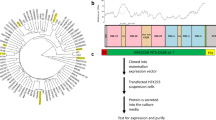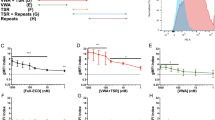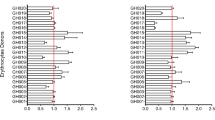Abstract
Infection with Plasmodium falciparum during pregnancy leads to the accumulation of parasite-infected erythrocytes in the placenta1, and is associated with excess perinatal mortality, premature delivery and intrauterine growth retardation in the infant, as well as increased maternal mortality and morbidity2,3. P. falciparum can adhere to specific receptors on host cells, an important virulence factor enabling parasites to accumulate in various organs4. We report here that most P. falciparum isolates from infected placentae can bind to hyaluronic acid, a newly discovered receptor for parasite adhesion that is present on the placental lining. In laboratory isolates selected for specific high-level adhesion, binding to hyaluronic acid could be inhibited by dodecamer or larger oligosaccharide fragments or polysaccharides, treatment of immobilized receptor with hyaluronidase, or treatment of infected erythrocytes with trypsin. In vitro flow-based assays demonstrated that high levels of adhesion occurred at low wall shear stress, conditions thought to prevail in the placenta. Our findings indicate that adhesion to hyaluronic acid is involved in mediating placental parasite accumulation, thus changing the present understanding of the mechanisms of placental infection, with implications for the development of therapeutic and preventative interventions.
This is a preview of subscription content, access via your institution
Access options
Subscribe to this journal
Receive 12 print issues and online access
$209.00 per year
only $17.42 per issue
Buy this article
- Purchase on Springer Link
- Instant access to full article PDF
Prices may be subject to local taxes which are calculated during checkout



Similar content being viewed by others
References
Walter, P.R., Garin, Y. & Blot, P. Placental pathologic changes in malaria. Am. J. Pathol. 109, 330–342 (1982).
Brabin, B.J. An analysis of malaria in pregnancy in Africa. Bull. WHO 61, 1005–1016 (1983).
McGregor, I.A. Epidemiology, malaria and pregnancy. Am. J. Trop. Med. Hyg. 33, 517–525 (1984).
Newbold, C.I. et al. PfEMP1, polymorphism and pathogenesis. Ann. Trop. Med. Parasitol. 91, 551–557 (1997).
Martin, B.J., Spicer, S.S. & Smythe, N.M. Cytochemical studies of the maternal surface of the syncytiotrophoblast of human early and term placenta. Anat. Rec. 178, 769–786 ( 1973).
Sunderland, C.A., Bulmer, J.N., Luscombe, M., Redman, C.W.G. & Stirrat, G.M. Immunohistological and biochemical evidence for a role for hyaluronic acid in the growth and development of the placenta. J. Reproduct. Immunol. 8, 197– 212 (1985).
Kirby, D.R.S., Billington, W.D., Bradbury, S. & Goldstein, D.J. The antigen barrier of the mouse placenta. Nature 204 , 548–549 (1964).
Laurent, T.C. & Fraser, J.R.E. Hyaluronan. FASEB J. 6, 2397–2404 ( 1992).
Fried, M. & Duffy, P.E. Adherence of Plasmodium falciparum to chondroitin sulfate A in the human placenta. Science 272, 1502–1504 (1996).
Beeson, J.G. et al. Plasmodium falciparum isolates from infected pregnant women and children are associated with distinct adhesive and antigenic properties . J. Infect. Dis. 180, 464– 472 (1999).
Rogerson, S.J., Chaiyaroj, S.C., Ng, K., Reeder, J.C. & Brown, G.V. Chondroitin sulfate A is a cell surface receptor for Plasmodium falciparum-infected erythrocytes. J. Exp. Med. 182, 15–20 (1995).
Gardner, J.P., Pinches, R.A., Roberts, D.J. & Newbold, C.I. Variant antigens and endothelial receptor adhesion in Plasmodium falciparum . Proc. Natl. Acad. Sci. USA 93, 3503 –3508 (1996).
Cooke, B.M. & Coppel, R.L. Cytoadhesion and falciparum malaria: going with the flow. Parasitol. Today 11, 282–287 (1995).
Ramsey, E.M. & Donner, M.W. (1980). Placental Vasculature and Circulation: Anatomy, Physiology, Radiology, Clinical Aspects: Atlas and Textbook. (Saunders, Philadelphia, Pennsylvania, 1980).
Chien, S. in Hemodilution. Theoretical Basis and Clinical Application (eds. Messmer, K & Schnid-Schönbein, H.) 1–45 (S. Karger, Basel, 1972).
McCormick, C.J., Craig, A., Roberts, D., Newbold, C.I. & Berendt, A.R. Intercellular adhesion molecule-1 and CD36 synergize to mediate adherence of Plasmodium falciparum-infected erythrocytes to cultured human microvascular endothelial cells. J. Clin. Invest. 100, 2521–2529 ( 1997).
Lea, R.G. & Calder, A.A. The immunology of pregnancy. Curr. Opin. Infect. Dis. 10, 171–176 (1997).
Biggs, B.A. et al. Adherence of infected erythrocytes to venular endothelium selects for antigenic variants of Plasmodium falciparum. J. Immunol. 149, 2047–2054 (1992).
Beeson, J.G., Chai, W., Rogerson, S.J., Lawson, A.M. & Brown, G.V. Inhibition of binding of malaria-infected erythrocytes by a tetradecasaccharide fraction from chondroitin sulfate A. Infect. Immun. 66, 3397–3402 (1998).
Kutner, S., Breuer, W.V., Ginsburg, H., Aley, S.B. & Cabantchik, Z.I. Characterization of permeation pathways in the plasma membrane of human erythrocytes infected with early stages of Plasmodium falciparum: association with parasite development . J. Cell. Physiol. 125, 521– 527 (1985).
Cowman, M.K., Balazs, E.A., Bergmann, C.W. & Meyer, K. Preparation and circular dichroism analysis of sodium hyaluronate oligosaccharides and chondroitin. Biochem. 20, 1379– 1385 (1981).
Bitter, T. & Muir, H.M. A modified uronic acid carbozole reaction. Anal. Biochem 4, 330– 4 (1962).
Chai, W., Lawson, A.M., Gradwell, M.J. & Kogelberg, H. Structural characterization of two hexasaccharides and an octasaccharide from chondroitin sulfate C containing the unusual sequence (4-sulpho)-N-acetylgalactosamine-1-4-(2-sulpho)-glucuronic acid-1-3-(6-sulpho)-N-acetylgalactosamine. Eur. J. Biochem. 251, 114–121 ( 1998).
Cooke, B.M., Nicoll, C.L., Baruch, D.I. & Coppel, R.L. A recombinant peptide based on PfEMP1 blocks and reverses adhesion of malaria-infected red blood cells to CD36 under flow. Mol. Microbiol. 30, 83–90 (1998).
Acknowledgements
Human erythrocytes and serum were provided by the Red Cross Blood Bank (Victoria, Australia). The authors thank E. Chaluluka and R. Tembenu for assistance with sample collection and processing; C. Nicoll for assistance with flow-based adhesion assays; R.A. Childs for FPLC analysis; and C. Bradshaw, V. Lema and T. Taylor for support. Thanks also go to C. Mhango and the staff of the Antenatal Clinic and Labour Ward of the Queen Elizabeth Central Hospital (Blantyre, Malawi) for cooperation, and to all individuals who participated in the study. This study was supported by funding from the National Health and Medical Research Council of Australia, the Wellcome Trust, UK, the District 9680 Rotary Against Malaria Programme, Australia, and the Medical Research Council, UK.
Author information
Authors and Affiliations
Corresponding author
Rights and permissions
About this article
Cite this article
Beeson, J., Rogerson, S., Cooke, B. et al. Adhesion of Plasmodium falciparum-infected erythrocytes to hyaluronic acid in placental malaria. Nat Med 6, 86–90 (2000). https://doi.org/10.1038/71582
Received:
Accepted:
Issue Date:
DOI: https://doi.org/10.1038/71582
This article is cited by
-
Reduced risk of placental parasitemia associated with complement fixation on Plasmodium falciparum by antibodies among pregnant women
BMC Medicine (2021)
-
Leishmaniasis and glycosaminoglycans: a future therapeutic strategy?
Parasites & Vectors (2018)
-
Impact of placental Plasmodium falciparum malaria infection on the Cameroonian maternal and neonate’s plasma levels of some cytokines known to regulate T cells differentiation and function
Malaria Journal (2016)
-
Real-time measurement of Plasmodium falciparum-infected erythrocyte cytoadhesion with a quartz crystal microbalance
Malaria Journal (2016)
-
Diagnosis of placental malaria in poorly fixed and processed placental tissue
Malaria Journal (2016)



